Birds
Magpies
A group of Magpies can be termed :- a Charm, a Murder, a Congregation, a Mischief, a Gulp or a Tittering.
Bird window strikes
The American Bird Conservancy and the Smithsonian Institution estimated 330 million to 1 Billion birds die annually in the USA from striking windows. The British Trust for Ornithology estimate up to 30 million die this way in the UK.
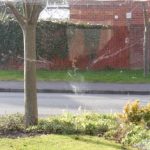
In the last 5 years our windows received two Pigeon strikes and one Blackbird strike resulting in broken necks in each case.
Foxes
In 1995 the Joint Nature Conservancy Council found 195,000 breeding foxes in England but only 23,000 in Scotland.
Deer
Fallow Deer
Fallow Deer have been resident in Britain for so long that they are considered resident. They are the most widespread deer in England. They are essentially herd animals with usually a single fawn being born late May to late June. The fawn stays with the mother until a year old when the next fawn is born. In terms of crop damage the Fallow Deer being a herd animal creates more of a problem for farmers compared to the Roe & Muntjac Deer.
Roe Deer
Roe Deer are found throughout Britain and are considered the most attractive of the British deer. They are graceful with a delicate build and have a combination of curiosity and reticence. The social unit is more solitary being a family group of the buck, doe and usually two fawns with fawns being born late May to late June.
Muntjac Deer
Muntjac Deer are small Asiatic Deer which were introduced into Britain. They have established feral populations over a wide area of England. They are usually seen either singly or in a small family group. Unlike the other deer in Britain Muntjacs do not have a limited breeding season and breed throughout the seasons. Single fawns being born around 7 months apart.
Insects
Some 20,000 known species of insects live in the British Isles with 100,000 in Europe. They occupy almost every habitat, including our homes. They feed on almost every organic material from wood, blood, nectar and dung.
Dragonflies
There are 39 breeding species and two migrants found in the British Isles.
Dragonflies consist of two sub-orders: true Dragonflies and Damselflies. Dragonflies can further be divided into Hawkers and Darters.
Most Dragonflies live on average two to three weeks with six at the most.
Damselflies have an average life of one to two weeks with a maximum of eight.
In VC38 the county of Warwickshire there are nineteen species of true Dragonfly and twelve species of Damselfly reliably recorded in the county.
Spiders & Webs
Spiders and webs are commonly thought of together but only 17 out of the 37 spider families in Britain build webs in order to catch prey. The orb web is the structure children draw when depicting spiders it is only made by four spider families in Britain. In three of the families the silk spirals are coated with sticky glue.
Seven different web constructions are recognized among British spiders – orb, funnel, tangled, lacy, radial, hammock and purse.
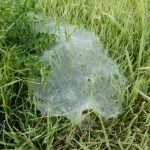
Hammock webs are built by the money spiders (Linyphiidae) the largest spider family in Britain. On a damp morning the extremely large number of webs built low down in a grassy field are made very visible when covered in dew.
Money Spiders make up about a third of all the spiders found in the UK.
These are the spiders which often land on your clothes in summer (said to bring fortune and good luck) because they travel through the air on strands of silk, picked up by the wind.
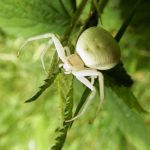
This female White Crab Spider from June 2020 page is one of the spiders to use the ambush tactics of stealth and surprise rather than making a web to catch its prey.
Crickets & Grasshoppers
There are 23 species of cricket and 11 species of grasshopper in the UK.
Tree & Plant Life
The photosynthesis chemical reaction equation forms the basis of all plant life.
6CO2 + 6H2O = C6H12O6 + 6O2
Carbon Dioxide + Water = Glucose + Oxygen
The leaves in presence of sunshine absorb carbon dioxide while the roots provide the water to the leaves. The resultant reaction provides glucose (the simplest form of carbohydrate) which grows the plant on which almost all life ultimately depends on.
Fungus
Apparently there are 4,000 species of larger fungus in the United Kingdom.
A study by the British Mycological Society completed in 1980 found 2,600 species of Fungus and Lichen in Warwickshire.
Fairy rings will increase radially each year.
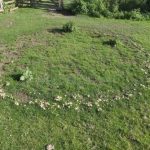
The oldest one known is 1 km in diameter and 700 years old.
The fused Fairy rings at Stonehenge are 100 m in diameter and 300 years old.
Slime moulds
Slime moulds in fact do not form part of the fungal kingdom. The nearly 500 species form a group of organisms distinct from all other forms of life.
This link give a better idea of how Slime moulds function -https://youtu.be/GY_uMH8Xpy0
Lichens
There are around 1800 active species listed in "The Lichens of Great Britain and Ireland". More are still being discovered each year, either new to the region or new to science. This compares with about 1760 species of native vascular plant.
The British Lichen Society Lichen Database January 2016 lists 439 species (taxa) for Warwickshire (VC38).
Lichens are 'dual' organisms. They consist of two (or more) different life-forms living together symbiotically in a more-or-less well defined body.
The main partner is the fungus. The other partner is a green alga. The fungus forms most of the body protecting the algae. The fungus is unable to produce food and relies on the algae to provide this by photosynthesis for them both.
Historically, lichen was used to generate dyes for clothes.
A lichenicolous fungus is a parasitic fungus that only lives on lichen (see January 2020 photographs for two forms that these take).
Catkins
Hazel is monecious. This means the male and female parts are found on the same tree. The yellow male catkins appear in February. The female part takes the form of a tiny bud with red protrusions which require to be fertilised by the male pollen from another tree. The fertilised female buds grow into nuts with each nut encased in a sheath of papery or modified leaves. The nuts ripen to brown during September/October.
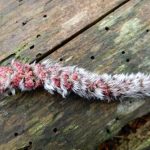
Aspen male catkin (75mm long) from the Aspen tree blown down in the wind. The aspen tree is dioecious where male and female catkins are on separate trees.
Galls
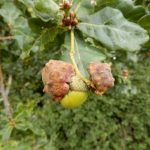
A gall is the result of a parasitic attack. This causes a growth reaction on the affected item.
The parasite generally a mite or insect results in an increase in the number of plant cells or by the cells becoming abnormally enlarged.
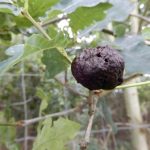
The parasite is not the actual gall maker rather it is the gall initiator for the host to create a localised growth which provides safe shelter and food for the lavre of the parasite.
Algae
The green alga represents the earliest known form of life on the earth.
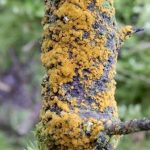
Free living species are mostly yellow to bright orange or red-brown in colour, due to the orange pigment which hides the green of the chlorophyll. These are commonly found on rocks, walls and on tree bark.
Mosses
There are over 600 species of moss in Britain, some of which are endangered. Many require a microscope to distinguish between closely related species.
Liverworts
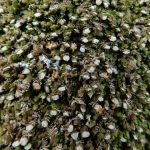
The liverworts are a group of simple small plants with flattened bodies, or with flattened stems bearing overlapping scales.
Scientists believe from DNA that liverworts were the first bryophyte to evolve. They believe that mosses, hornworts and more complex plants then evolved from liverworts.